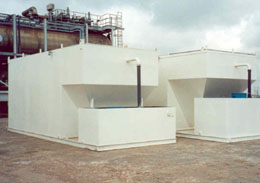Wastewater
and Effluent Recycling
 Global
Wastewater's proprietary extended aeration systems are applicable
for flows of a few hundred gallons to tens of millions of
gallons per day. There is NO SLUDGE to dispose, NO ODOR, and
our systems require very little maintenance. The Global process
is designed around modularization to be able to grow a system
efficiently and quickly as needs grow. Call the Global Water
represenative at Energistx for systems engineered for your
specific application: 866-733-8686
Para Espanol Marque Aqui Global
Wastewater's proprietary extended aeration systems are applicable
for flows of a few hundred gallons to tens of millions of
gallons per day. There is NO SLUDGE to dispose, NO ODOR, and
our systems require very little maintenance. The Global process
is designed around modularization to be able to grow a system
efficiently and quickly as needs grow. Call the Global Water
represenative at Energistx for systems engineered for your
specific application: 866-733-8686
Para Espanol Marque Aqui
 Applications Applications
Appropriate
in applications for municipalities, villages, condominiums,
schools, restaurants, motels, hotels, mobile home parks, processing
plants, industrial plants, animal farms, oilfield platform
rigs, oilfield jack-up rigs, oilfield posted and inland drilling
barges, fixed structures offshore or anywhere sewage collection
is required. These models can be constructed of standard configurations
or engineered for custom designed special configurations.
These systems are also suitable and utilized on land for package
sewage treatment applications for communities as well as individual
commercial sites. View
Wastewater and Effluent Recycling Catalogue
Operating the System
Raw
sewage enters the unit through the influent line and passes
through a bar screen, which keeps out any large solids. A
diffuser system introduces air into the aeration chamber.
The air bubbles that are generated provide the oxygen necessary
to sustain the bacteria and also provide the agitation necessary
to reduce solids to small particles.
After a suitable retention time, the solution
is displaced from the aeration chamber to the clarifier chamber.
There the remaining solids settle to the bottom in the form
of activated sludge. The sludge is returned to the aeration
chamber to maintain a high active bacteria count. The clear
liquid at the top of the clarifier chamber flows into the
LS3 wastewater purification system to kill any disease-carrying
bacteria that remain. The effluent is then purified into polished
quality drinking water.
3-Step
Process
•
Use bacteria to eliminate waste in the water
• Separate the bacterial
sludge from the water
• Disinfect and polish
with Global's LS3 Recycling and Water Purification System
Explanation of the
Wastewater and Recycling System
The
first aspect of understanding, regarding the Global Water
process, is that it is more environmentally correct and efficient
to recycle wastewater than to just try to clean it and hope
that the effluent doesn't ruin your land, your beaches, or
your lives.
Most wastewater processing now results in "dumping"
the effluent flow into the lakes, bays, rivers or right onto
the land. The "sludge" from wastewater "drying
ponds" is "dumped," left on the land, or processed
into a fertilizer (with sometimes questionable ingredients).
The Global process is to totally destroy and
eliminate all waste products from the wastewater stream and
then recycle the effluent flow back to the quality of drinking
water. Then to disperse that final, clean effluent back into
the bay, or into reservoirs for reuse, or into useful water
sources for maintenance, agriculture or other needs is the
only way to preserve a higher quality of life and preserve
our land.
Global's proprietary Wastewater Process is what
we consider to be the best currently available when analyzing
ease in installation, ease in operations, minimal maintenance
and resulting effluent (output). The Global process is designed
around modularization to be able to grow a system efficiently
and quickly as needs grow.
The normal processing time for an extended aeration
system is 24 hours to turn out effluent from a high quality
wastewater system that can be put back into the ground (after
chlorination). Because the Global Recycling-Water System is
so effective, we can pull the effluent from the wastewater
system in ONLY 12 HOURS. Therefore, the wastewater system
needs to be only HALF THE SIZE. For a 1,000,000 gallon per
day requirement (1MGPD), you only need to have a 500,000 GPD
wastewater system (that will cycle twice per 24 hours)! Then
you would need a 1MGPD Global Recycling-Water System to recycle
all 1,000,000 GPD.
The cost of both components in this configuration
is about the same as just utilizing only the full sized wastewater
component.
Understanding the Process
Global
Wastewater systems utilize the biological treatment process
to clean up sewage. All of the sewage input is food for microorganisms.
Raw sewage is consumed by the microorganisms and is used to
provide energy for cell activity and material for cell reproduction.
These processes are called respiration and synthesis.
For years municipal sewage treatment plants
use biological in one form or other. The process of biological
treatment is proven and most economical.
The prime factor of biological treatment processes
is that the microorganisms (mostly bacteria) are able to easily
remove organic wastes from a liquid that would otherwise be
very difficult and expensive to remove by other means.
There are two types of bacteria used for biological
sewage treatment systems and they both are naturally contained
in the sewage.
One type is anaerobic bacteria. This type does
not require oxygen for their metabolism. They will consume
the organic waste material in sewage, but release methane
and hydrogen sulfide gas as a by-product. Both of these gases
are explosive, and the hydrogen sulfide produces the offensive
odor associated with this process. In addition to become efficient,
anaerobic processes require some form of heating. These reasons
have precluded the use of anaerobic bacteria for package type
sewage treatment units.
The second type of bacteria is aerobic. They
must have oxygen for their respiration and synthesis process.
They consume the organic waste material in sewage and release
carbon dioxide and water vapor as by-products. This does not
result in any odor or explosive hazard. No special heating
requirements are needed, if the sewage treatment units are
located where hard freezes do not occur. The aerobic process
is also faster than the anaerobic process, with regard to
waste reduction reaction rates.
If the sewage is permitted to become stale and
subsequently to become septic, its odor becomes pronounced,
it turns black, the solids disintegrate and decompose, the
dissolved oxygen is used up, and the formation of hydrogen
sulfide starts.
Both anaerobic and aerobic treatment systems
are biological. That is, they depend on bacteria to consume
and eliminate the organic waste material in sewage. An aerobic
(air required) sewage treatment process, if the air supply
is cut off. It will be a gradual change, and the odor will
increase as the process becomes more anaerobic. However, the
process will revert back to an aerobic process once the air
supply is restored. It can take twelve to thirty-six hours
for an aerobic system to become anaerobic, depending on unit
size of loading.
Global Wastewater's proprietary sewage treatment
unit utilizes a type of aerobic biological treatment process
called an "extended aeration activated sludge" process.
The microorganism or bacterial cell mass that
is generated by cell reproduction is separated from the liquid
being treated prior to discharge, collected, and mixed with
incoming sewage. This increases the rate of removal of the
organic waste coming into the system, because the waste comes
in direct contact with a hungry a relatively dense population
of bacteria almost immediately. This arrangement is called
an "activated sludge" process.
Global's extended aeration treatment process
creates a super-charged environment for the bacteria to generate
more digestion in less time, enabling the recycling system
to initialize its process much quicker. This arrangement keeps
the ratio of bacteria population (sludge) to the available
food supply (sewage) essentially constant. The bacteria cells
are continuously multiplying, and the cell population exceeds
the food supply available for feeding the excess population.
These cells starve to death and become food for the survivors.
The result of this process is to minimize bacterial cell sludge
accumulation in the sewage treatment unit.
Global Water's Recycling
Process
Global's
Wastewater System has an enhanced efficiency with a Global
Recycling-Water System. The Global Recycling-Water System
will receive the effluent from the wastewater flow after only
(12) hours. It will then recycle all suspended solids back
to the wastewater unit.
The remaining effluent will be processed through
Global's water purification process just as any other contaminated
water source. Any remaining parasites and hazardous chemicals
will be removed, and then all effluent will be treated with
ultra-violet lamps to kill all bacteria (e-coli) and viruses.
The output of the Recycling-water system will
be totally recyclable for re-entering the environment (ground
or water disposal), being used for non-food or non-drinking
purposes (toilets, washing equipment, etc.), or actually being
potable for re-use.
Marine and Land-based
Systems
Global
Wastewater manufactures two distinct styles of equipment:
One geared for the Marine market (boats, barges and ships)
and one for land based environments.
Sewage treatment systems that do not employ
the extended aeration treatment concept will require continuous
drain off and disposal of sludge, because bacteria are not
kept away from a food supply long enough to keep the bacteria
population from increasing. As a result, the bacteria population
will continue to increase to a point where the sludge density
becomes so great, that sludge is discharged from the sewage
treatment unit.
Call us with any questions
toll-free about your water needs: 1-866-733-8686
|


 G
G Applications
Applications